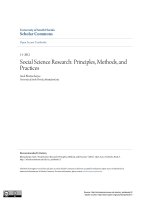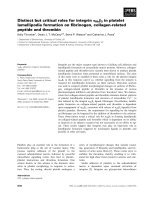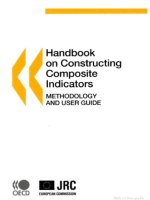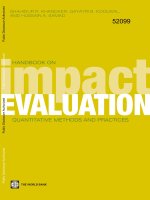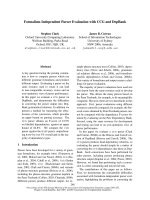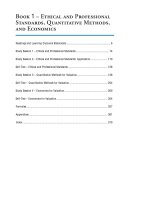Handbook on Impact Evaluation - Quantitative Methods and Practices pot
Bạn đang xem bản rút gọn của tài liệu. Xem và tải ngay bản đầy đủ của tài liệu tại đây (2.99 MB, 262 trang )
Public Disclosure AuthorizedPublic Disclosure AuthorizedPublic Disclosure AuthorizedPublic Disclosure Authorized
52099
Handbook on Impact
Evaluation
Handbook on Impact
Evaluation
Quantitative Methods and Practices
Shahidur R. Khandker
Gayatri B. Koolwal
Hussain A. Samad
© 2010 The International Bank for Reconstruction and Development / The World Bank
1818 H Street NW
Washington DC 20433
Telephone: 202-473-1000
Internet: www.worldbank.org
E-mail:
All rights reserved
1 2 3 4 13 12 11 10
This volume is a product of the staff of the International Bank for Reconstruction and Development / The World
Bank. The fi ndings, interpretations, and conclusions expressed in this volume do not necessarily refl ect the views
of the Executive Directors of The World Bank or the governments they represent.
The World Bank does not guarantee the accuracy of the data included in this work. The boundaries, colors,
denominations, and other information shown on any map in this work do not imply any judgement on the part of
The World Bank concerning the legal status of any territory or the endorsement or acceptance of such boundaries.
Rights and Permissions
The material in this publication is copyrighted. Copying and/or transmitting portions or all of this work without
permission may be a violation of applicable law. The International Bank for Reconstruction and Development /
The World Bank encourages dissemination of its work and will normally grant permission to reproduce portions
of the work promptly.
For permission to photocopy or reprint any part of this work, please send a request with complete information
to the Copyright Clearance Center Inc., 222 Rosewood Drive, Danvers, MA 01923, USA; telephone: 978-750-8400;
fax: 978-750-4470; Internet: www.copyright.com.
All other queries on rights and licenses, including subsidiary rights, should be addressed to the Offi ce
of the Publisher, The World Bank, 1818 H Street NW, Washington, DC 20433, USA; fax: 202-522-2422; e-mail:
ISBN: 978-0-8213-8028-4
eISBN: 978-0-8213-8029-1
DOI: 10.1596/978-0-8213-8028-4
Library of Congress Cataloging-in-Publication Data
Khandker, Shahidur R. Handbook on impact evaluation : quantitative methods and practices / Shahidur R.
Khandker, Gayatri B. Koolwal, Hussain A. Samad.
p. cm.
Includes bibliographical references and index.
ISBN 978-0-8213-8028-4 — ISBN 978-0-8213-8029-1 (electronic)
1. Economic development projects—Evaluation. 2. Economic assistance—Evaluation.
I. Koolwal, Gayatri B. II. Samad, Hussain A., 1963- III. Title.
HD75.9.K52 2009
338.90072—dc22
2009020886
Cover design by Patricia Hord.Graphik Design.
v
Contents
Foreword xiii
Preface xv
About the Authors xvii
Abbreviations xix
Part 1 Methods and Practices 1
1. Introduction 3
References 6
2. Basic Issues of Evaluation 7
Summary 7
Learning Objectives 7
Introduction: Monitoring versus Evaluation 8
Monitoring 8
Setting Up Indicators within an M&E Framework 9
Operational Evaluation 16
Quantitative versus Qualitative Impact Assessments 18
Quantitative Impact Assessment: Ex Post versus Ex Ante
Impact Evaluations 20
The Problem of the Counterfactual 22
Basic Theory of Impact Evaluation: The Problem of Selection Bias 25
Different Evaluation Approaches to Ex Post Impact Evaluation 27
Overview: Designing and Implementing Impact Evaluations 28
Questions 29
References 30
3. Randomization 33
Summary 33
Learning Objectives 33
vi
Contents
Setting the Counterfactual 34
Statistical Design of Randomization 34
Calculating Treatment Effects 35
Randomization in Evaluation Design: Different Methods
of Randomization 38
Concerns with Randomization 38
Randomized Impact Evaluation in Practice 39
Diffi culties with Randomization 47
Questions 49
Notes 51
References 51
4. Propensity Score Matching 53
Summary 53
Learning Objectives 53
PSM and Its Practical Uses 54
What Does PSM Do? 54
PSM Method in Theory 55
Application of the PSM Method 58
Critiquing the PSM Method 63
PSM and Regression-Based Methods 64
Questions 66
Notes 67
References 68
5. Double Difference 71
Summary 71
Learning Objectives 71
Addressing Selection Bias from a Different Perspective:
Using Differences as Counterfactual 71
DD Method: Theory and Application 72
Advantages and Disadvantages of Using DD 76
Alternative DD Models 78
Questions 82
Notes 84
References 84
vii
Contents
6. Instrumental Variable Estimation 87
Summary 87
Learning Objectives 87
Introduction 87
Two-Stage Least Squares Approach to IVs 89
Concerns with IVs 91
Sources of IVs 95
Questions 99
Notes 100
References 100
7. Regression Discontinuity and Pipeline Methods 103
Summary 103
Learning Objectives 103
Introduction 104
Regression Discontinuity in Theory 104
Advantages and Disadvantages of the RD Approach 108
Pipeline Comparisons 110
Questions 111
References 112
8. Measuring Distributional Program Effects 115
Summary 115
Learning Objectives 115
The Need to Examine Distributional Impacts of Programs 115
Examining Heterogeneous Program Impacts:
Linear Regression Framework 116
Quantile Regression Approaches 118
Discussion: Data Collection Issues 124
Notes 125
References 125
9. Using Economic Models to Evaluate Policies 127
Summary 127
Learning Objectives 127
Introduction 127
viii
Contents
Structural versus Reduced-Form Approaches 128
Modeling the Effects of Policies 130
Assessing the Effects of Policies in a Macroeconomic Framework 131
Modeling Household Behavior in the Case of a Single Treatment:
Case Studies on School Subsidy Programs 133
Conclusions 135
Note 136
References 137
10. Conclusions 139
Part 2 Stata Exercises 143
11. Introduction to Stata 145
Data Sets Used for Stata Exercises 145
Beginning Exercise: Introduction to Stata 146
Working with Data Files: Looking at the Content 151
Changing Data Sets 158
Combining Data Sets 162
Working with .log and .do Files 164
12. Randomized Impact Evaluation 171
Impacts of Program Placement in Villages 171
Impacts of Program Participation 173
Capturing Both Program Placement and Participation 175
Impacts of Program Participation in Program Villages 176
Measuring Spillover Effects of Microcredit Program Placement 177
Further Exercises 178
Notes 179
13. Propensity Score Matching Technique 181
Propensity Score Equation: Satisfying the Balancing Property 181
Average Treatment Effect Using Nearest-Neighbor Matching 185
Average Treatment Effect Using Stratifi cation Matching 186
Average Treatment Effect Using Radius Matching 186
Average Treatment Effect Using Kernel Matching 187
Checking Robustness of Average Treatment Effect 187
Further Exercises 188
Reference 188
ix
Contents
14. Double-Difference Method 189
Simplest Implementation: Simple Comparison Using “ttest” 189
Regression Implementation 190
Checking Robustness of DD with Fixed-Effects Regression 192
Applying the DD Method in Cross-Sectional Data 193
Taking into Account Initial Conditions 196
The DD Method Combined with Propensity Score Matching 198
Notes 201
Reference 201
15. Instrumental Variable Method 203
IV Implementation Using the “ivreg” Command 203
Testing for Endogeneity: OLS versus IV 205
IV Method for Binary Treatment: “treatreg” Command 206
IV with Fixed Effects: Cross-Sectional Estimates 207
IV with Fixed Effects: Panel Estimates 208
Note 209
16. Regression Discontinuity Design 211
Impact Estimation Using RD 211
Implementation of Sharp Discontinuity 212
Implementation of Fuzzy Discontinuity 214
Exercise 216
Answers to Chapter Questions 217
Appendix: Programs and .do Files for Chapter 12–16 Exercises 219
Index 231
Boxes
2.1 Case Study: PROGRESA (Oportunidades) in Mexico 10
2.2 Case Study: Assessing the Social Impact of Rural Energy Services in Nepal 13
2.3 Case Study: The Indonesian Kecamatan Development Project 15
2.4 Case Study: Monitoring the Nutritional Objectives of the FONCODES
Project in Peru 17
2.5 Case Study: Mixed Methods in Quantitative and Qualitative Approaches 19
2.6 Case Study: An Example of an Ex Ante Evaluation 21
x
Contents
3.1 Case Study: PROGRESA (Oportunidades) 40
3.2 Case Study: Using Lotteries to Measure Intent-to-Treat Impact 43
3.3 Case Study: Instrumenting in the Case of Partial Compliance 44
3.4 Case Study: Minimizing Statistical Bias Resulting from Selective Attrition 44
3.5 Case Study: Selecting the Level of Randomization to Account for Spillovers 45
3.6 Case Study: Measuring Impact Heterogeneity from a Randomized Program 46
3.7 Case Study: Effects of Conducting a Baseline 48
3.8 Case Study: Persistence of Unobserved Heterogeneity in a
Randomized Program 48
4.1 Case Study: Steps in Creating a Matched Sample of Nonparticipants to
Evaluate a Farmer-Field-School Program 62
4.2 Case Study: Use of PSM and Testing for Selection Bias 65
4.3 Case Study: Using Weighted Least Squares Regression in a Study of
the Southwest China Poverty Reduction Project 66
5.1 Case Study: DD with Panel Data and Repeated Cross-Sections 76
5.2 Case Study: Accounting for Initial Conditions with a DD Estimator—
Applications for Survey Data of Varying Lengths 79
5.3 Case Study: PSM with DD 80
5.4 Case Study: Triple-Difference Method—Trabajar Program in Argentina 81
6.1 Case Study: Using Geography of Program Placement as an
Instrument in Bangladesh 96
6.2 Case Study: Different Approaches and IVs in Examining the Effects
of Child Health on Schooling in Ghana 97
6.3 Case Study: A Cross-Section and Panel Data Analysis Using
Eligibility Rules for Microfi nance Participation in Bangladesh 97
6.4 Case Study: Using Policy Design as Instruments to Study Private
Schooling in Pakistan 98
7.1 Case Study: Exploiting Eligibility Rules in Discontinuity
Design in South Africa 107
7.2 Case Study: Returning to PROGRESA (Oportunidades) 110
7.3 Case Study: Nonexperimental Pipeline Evaluation in Argentina 111
8.1 Case Study: Average and Distributional Impacts of the SEECALINE
Program in Madagascar 119
8.2 Case Study: The Canadian Self-Suffi ciency Project 121
8.3 Case Study: Targeting the Ultra-Poor Program in Bangladesh 122
9.1 Case Study: Poverty Impacts of Trade Reform in China 132
9.2 Case Study: Effects of School Subsidies on Children’s Attendance
under PROGRESA (Oportunidades) in Mexico: Comparing Ex Ante
Predictions and Ex Post Estimates—Part 1 134
xi
Contents
9.3 Case Study: Effects of School Subsidies on Children’s Attendance under
PROGRESA (Oportunidades) in Mexico: Comparing Ex Ante Predictions
and Ex Post Estimates—Part 2 134
9.4 Case Study: Effects of School Subsidies on Children’s Attendance under
Bolsa Escola in Brazil 136
Figures
2.1 Monitoring and Evaluation Framework 9
2.A Levels of Information Collection and Aggregation 13
2.B Building up of Key Performance Indicators: Project Stage Details 14
2.2 Evaluation Using a With-and-Without Comparison 23
2.3 Evaluation Using a Before-and-After Comparison 24
3.1 The Ideal Experiment with an Equivalent Control Group 34
4.1 Example of Common Support 57
4.2 Example of Poor Balancing and Weak Common Support 57
5.1 An Example of DD 75
5.2 Time-Varying Unobserved Heterogeneity 77
7.1 Outcomes before Program Intervention 105
7.2 Outcomes after Program Intervention 106
7.3 Using a Tie-Breaking Experiment 108
7.4 Multiple Cutoff Points 109
8.1 Locally Weighted Regressions, Rural Development Program
Road Project, Bangladesh 117
11.1 Variables in the 1998/99 Data Set 147
11.2 The Stata Computing Environment 148
Table
11.1 Relational and Logical Operators Used in Stata 153
xiii
Foreword
Identifying the precise effects of a policy is a complex and challenging task. This
issue is particularly salient in an uncertain economic climate, where governments
are under great pressure to promote programs that can recharge growth and reduce
poverty. At the World Bank, our work is centered on aid effectiveness and how to
improve the targeting and effi cacy of programs that we support. As we are well
aware, however, times of crisis as well as a multitude of other factors can inhibit a
clear understanding of how interventions work—and how effective programs can
be in the long run.
Handbook on Impact Evaluation: Quantitative Methods and Practices makes a valu-
able contribution in this area by providing, for policy and research audiences, a com-
prehensive overview of steps in designing and evaluating programs amid uncertain
and potentially confounding conditions. It draws from a rapidly expanding and broad-
based literature on program evaluation—from monitoring and evaluation approaches
to experimental and nonexperimental econometric methods for designing and con-
ducting impact evaluations.
Recent years have ushered in several benefi ts to policy makers in designing and
evaluating programs, including improved data collection and better forums to share
data and analysis across countries. Harnessing these benefi ts, however, depends on
understanding local economic environments by using qualitative as well as quantita-
tive approaches. Although this Handbook has a quantitative emphasis, several case
studies are also presented of methods that use both approaches in designing and
assessing programs.
The vast range of ongoing development initiatives at institutions such as the World
Bank, as well as at other research and policy institutions around the world, provide an
(albeit wieldy) wealth of information on interpreting and measuring policy effects.
This Handbook synthesizes the spectrum of research on program evaluation, as well
as the diverse experiences of program offi cials in the fi eld. It will be of great interest
to development practitioners and international donors, and it can be used in training
and building local capacity. Students and researchers embarking on work in this area
will also fi nd it a useful guide for understanding the progression and latest methods on
impact evaluation.
xiv
Foreword
I recommend this Handbook for its relevance to development practitioners and
researchers involved in designing, implementing, and evaluating programs and policies
for better results in the quest of poverty reduction and socioeconomic development.
Justin Yifu Lin
Senior Vice President and Chief Economist
Development Economics
The World Bank
xv
Preface
Evaluation approaches for development programs have evolved considerably over the
past two decades, spurred on by rapidly expanding research on impact evaluation and
growing coordination across different research and policy institutions in designing
programs. Comparing program effects across different regions and countries is also
receiving greater attention, as programs target larger populations and become more
ambitious in scope, and researchers acquire enough data to be able to test specifi c pol-
icy questions across localities. This progress, however, comes with new empirical and
practical challenges.
The challenges can be overwhelming for researchers and evaluators who often have
to produce results within a short time span after the project or intervention is con-
ceived, as both donors and governments are keen to regularly evaluate and monitor aid
effectiveness. With multiple options available to design and evaluate a program, choos-
ing a particular method in a specifi c context is not always an easy task for an evaluator,
especially because the results may be sensitive to the context and methods applied. The
evaluation could become a frustrating experience.
With these issues in mind, we have written the Handbook on Impact Evaluation
for two broad audiences—researchers new to the evaluation fi eld and policy makers
involved in implementing development programs worldwide. We hope this book will
offer an up-to-date compendium that serves the needs of both audiences, by presenting
a detailed analysis of the quantitative research underlying recent program evaluations
and case studies that refl ect the hands-on experience and challenges of researchers and
program offi cials in implementing such methods.
The Handbook is based on materials we prepared for a series of impact evaluation
workshops in different countries, sponsored by the World Bank Institute (WBI). In
writing this book, we have benefi tted enormously from the input and support of a
number of people. In particular, we would like to thank Martin Ravallion who has
made far-reaching contributions to research in this area and who taught with Shahid
Khandker at various WBI courses on advanced impact evaluation; his work has helped
shape this book. We also thank Roumeen Islam and Sanjay Pradhan for their support,
which was invaluable in bringing the Handbook to completion.
We are grateful to Boniface Essama-Nssah, Jonathan Haughton, Robert Moffi tt,
Mark Pitt, Emmanuel Skoufi as, and John Strauss for their valuable conversations and
xvi
Preface
input into the conceptual framework for the book. We also thank several researchers
at the country institutions worldwide who helped organize and participate in the
WBI workshops, including G. Arif Khan and Usman Mustafa, Pakistan Institute
for Development Economics (PIDE); Jirawan Boonperm and Chalermkwun Chi-
emprachanarakorn, National Statistics Offi ce of Thailand; Phonesaly Souksavath,
National Statistics Offi ce of Lao PDR; Jose Ramon Albert and Celia Reyes, Philippine
Institute for Development Economics; Matnoor Nawi, Economic Planning Unit of
Malaysia; and Zhang Lei, International Poverty Reduction Center in China. We would
also like to thank the participants of various WBI-sponsored workshops for their
comments and suggestions.
Finally, we thank the production staff of the World Bank for this book, including
Denise Bergeron, Stephen McGroarty, Erin Radner, and Dina Towbin at the World
Bank Offi ce of the Publisher, and Dulce Afzal and Maxine Pineda at the WBI. Putting
together the different components of the book was a complex task, and we appreciate
their support.
xvii
About the Authors
Shahidur R. Khandker (PhD, McMaster University, Canada, 1983) is a lead econo-
mist in the Development Research Group of the World Bank. When this Handbook was
written, he was a lead economist at the World Bank Institute. He has authored more
than 30 articles in peer-reviewed journals, including the Journal of Political Economy,
The Review of Economic Studies, and the Journal of Development Economics; authored
several books, including Fighting Poverty with Microcredit: Experience in Bangladesh,
published by Oxford University Press; co-authored with Jonathan Haughton, the
Handbook on Poverty and Inequality, published by the World Bank; and, written several
book chapters and more than two dozen discussion papers at the World Bank on pov-
erty, rural fi nance and microfi nance, agriculture, and infrastructure. He has worked in
close to 30 countries. His current research projects include seasonality in income and
poverty, and impact evaluation studies of rural energy and microfi nance in countries
in Africa, Asia, and Latin America
.
Gayatri B. Koolwal (PhD, Cornell University, 2005) is a consultant in the Poverty Reduc-
tion and Economic Management Network, Gender and Development, at the World
Bank. Her current research examines the distributional impacts of rural infrastructure
access and the evolution of credit markets in developing countries. She recently taught
an impact evaluation workshop at the Pakistan Institute of Development Economics
(PIDE) through the World Bank Institute. Her research has been published in Economic
Development and Cultural Change and in the Journal of Development Studies.
Hussain A. Samad (MS, Northeastern University, 1992) is a consultant at the World
Bank with about 15 years of experience in impact assessment, monitoring and evalua-
tion, data analysis, research, and training on development issues. He has been involved
in various aspects of many World Bank research projects—drafting proposals, design-
ing projects, developing questionnaires, formulating sampling strategies and planning
surveys, as well as data analysis. His research interests include energy and rural elec-
trifi cation, poverty, micro-credit, infrastructure, and education. Mr. Samad designed
course materials for training and conducted hands-on training in workshops in several
countries.
xix
Abbreviations
2SLS two-stage least squares
AEPC Alternative Energy Promotion Center (Nepal)
ATE average treatment effect
ATT average treatment of the treated
BRAC Bangladesh Rural Advancement Committee
CO community organization
DD double-difference (methods)
FAQs frequently asked questions
FFS farmer-fi eld-school
FONCODES Fondo de Cooperación para el Desarrollo Social,
or Cooperation Fund for Social Development (Peru)
GPS global positioning system
GSS girls’ secondary schools
IA Income Assistance (program) (Canada)
IE impact evaluation
ITT intention-to-treat (impact)
IV instrumental variable
JSIF Jamaica Social Investment Fund
KDP Kecamatan Development Program (Indonesia)
LATE local average treatment effect
LLM local linear matching
M&E monitoring and evaluation
MTE marginal treatment effect
NN nearest-neighbor (matching)
OLS ordinary least squares
PACES Plan de Ampliación de Cobertura de la Educación Secundaria,
or Plan for Increasing Secondary Education Coverage (Colombia)
PC Patwar Circle (Pakistan)
PROGRESA Programa de Educación, Salud y Alimentación,
or Education, Health, and Nutrition Program (Mexico)
PRS Poverty Reduction Strategy
PSM propensity score matching
QDD quantile difference-in-difference (approach)
QTE quantile treatment effect
xx
Abbreviations
RD regression discontinuity
REDP Rural Electrifi cation Development Program (Nepal)
SEECALINE Surveillance et Éducation d’Écoles et des Communautés en Matière
d’Alimentation et de Nutrition Élargie,
or Expanded School and Community Food and Nutrition Surveillance
and Education (program) (Madagascar)
SIIOP Sistema Integral de Información para la Operación de
Oportunidades,
or Complete Information System for the Operation of
Oportunidades (Mexico)
SSP Self-Suffi ciency Project (Canada)
SWP Southwest China Poverty Reduction Project
TOT treatment effect on the treated
TUP Targeting the Ultra-Poor Program (Bangladesh)
PART 1
Methods and Practices
3
1. Introduction
Public programs are designed to reach certain goals and benefi ciaries. Methods to
understand whether such programs actually work, as well as the level and nature of
impacts on intended benefi ciaries, are main themes of this book. Has the Grameen
Bank, for example, succeeded in lowering consumption poverty among the rural poor
in Bangladesh? Can conditional cash-transfer programs in Mexico and other Latin
American countries improve health and schooling outcomes for poor women and chil-
dren? Does a new road actually raise welfare in a remote area in Tanzania, or is it a
“highway to nowhere”? Do community-based programs like the Thailand Village Fund
project create long-lasting improvements in employment and income for the poor?
Programs might appear potentially promising before implementation yet fail to gen-
erate expected impacts or benefi ts. The obvious need for impact evaluation is to help
policy makers decide whether programs are generating intended effects; to promote
accountability in the allocation of resources across public programs; and to fi ll gaps in
understanding what works, what does not, and how measured changes in well-being are
attributable to a particular project or policy intervention.
Effective impact evaluation should therefore be able to assess precisely the mecha-
nisms by which benefi ciaries are responding to the intervention. These mechanisms
can include links through markets or improved social networks as well as tie-ins with
other existing policies. The last link is particularly important because an impact eval-
uation that helps policy makers understand the effects of one intervention can guide
concurrent and future impact evaluations of related interventions. The benefi ts of
a well-designed impact evaluation are therefore long term and can have substantial
spillover effects.
This book reviews quantitative methods and models of impact evaluation. The for-
mal literature on impact evaluation methods and practices is large, with a few useful
overviews (for example, Blundell and Dias 2000; Dufl o, Glennerster, and Kremer 2008;
Ravallion 2008). Yet there is a need to put the theory into practice in a hands-on fash-
ion for practitioners. This book also details challenges and goals in other realms of
evaluation, including monitoring and evaluation (M&E), operational evaluation, and
mixed-methods approaches combining quantitative and qualitative analyses.
Broadly, the question of causality makes impact evaluation different from M&E
and other evaluation approaches. In the absence of data on counterfactual outcomes
4
Handbook on Impact Evaluation
(that is, outcomes for participants had they not been exposed to the program), impact
evaluations can be rigorous in identifying program effects by applying different mod-
els to survey data to construct comparison groups for participants. The main question
of impact evaluation is one of attribution—isolating the effect of the program from
other factors and potential selection bias.
Impact evaluation spans qualitative and quantitative methods, as well as ex ante
and ex post methods. Qualitative analysis, as compared with the quantitative approach,
seeks to gauge potential impacts that the program may generate, the mechanisms of
such impacts, and the extent of benefi ts to recipients from in-depth and group-based
interviews. Whereas quantitative results can be generalizable, the qualitative results may
not be. Nonetheless, qualitative methods generate information that may be critical for
understanding the mechanisms through which the program helps benefi ciaries.
Quantitative methods, on which this book focuses, span ex ante and ex post
approaches. The ex ante design determines the possible benefi ts or pitfalls of an inter-
vention through simulation or economic models. This approach attempts to predict the
outcomes of intended policy changes, given assumptions on individual behavior and
markets. Ex ante approaches often build structural models to determine how different
policies and markets interlink with behavior at the benefi ciary level to better understand
the mechanisms by which programs have an impact. Ex ante analysis can help in refi n-
ing programs before they are implemented, as well as in forecasting the potential effects
of programs in different economic environments. Ex post impact evaluation, in con-
trast, is based on actual data gathered either after program intervention or before and
after program implementation. Ex post evaluations measure actual impacts accrued by
the benefi ciaries because of the program. These evaluations, however, sometimes miss
the mechanisms underlying the program’s impact on the population, which structural
models aim to capture. These mechanisms can be very important in understanding
program effectiveness (particularly in future settings).
Although impact evaluation can be distinguished from other approaches to evalua-
tion, such as M&E, impact evaluation can or should not necessarily be conducted inde-
pendently of M&E. M&E assesses how an intervention evolves over time, evaluating
data available from the project management offi ce in terms of initial goals, indicators,
and outcomes associated with the program. Although M&E does not spell out whether
the impact indicators are a result of program intervention, impact evaluations often
depend on knowing how the program is designed, how it is intended to help the target
audience, and how it is being implemented. Such information is often available only
through operational evaluation as part of M&E. M&E is necessary to understand the
goals of a project, the ways an intervention can take place, and the potential metrics
to measure effects on the target benefi ciaries. Impact evaluation provides a frame-
work suffi cient to understand whether the benefi ciaries are truly benefi ting from the
program—and not from other factors.


